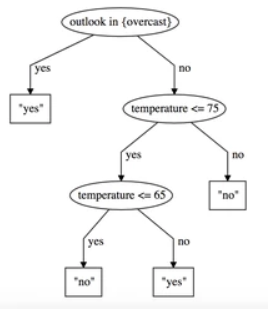Decision Tree Classification - CART
Uses the MADlib built-in function
tree_train() to generate a decision tree that predicts the value of a categorical column based on several independent columns.

Information at a Glance
|
Parameter |
Description |
|---|---|
| Category | Model |
| MADlib version | 1.8+ |
| Data source type | DB |
| Send output to other operators | Yes |
| Data processing tool | n/a |
The generated tree is a binary tree, with each node representing either a branching condition or a predicted value. The output of the operator can be sent to a predictor or confusion matrix. MADlib 1.8 or higher must be installed on the database.
For more information about working with decision trees, see Classification Modeling with Decision Tree.
Input
The input table must have a single, categorical (string or integer) column to predict, and one or more independent columns to serve as input.
Restrictions
- This operator works only on databases with MADlib 1.8+ installed.
- Source data tables must have a numeric ID column that uniquely identifies each row in the source table.
- The prediction column must be numeric, and all predictions are double-precision values.
Configuration
| Parameter | Description |
|---|---|
| Notes | Notes or helpful information about this operator's parameter settings. When you enter content in the Notes field, a yellow asterisk appears on the operator. |
| MADlib Schema | Name of schema where MADlib is installed. By default, this is madlib. |
| Model Output Schema | The name of the schema to use for MADlib-generated output tables. |
| Model Output Table | The name of the MADlib-generated output table. This table is generated by the tree trainer. An additional table with the same name and the suffix _summary also is generated. |
| Drop If Exists |
|
| ID column | All source tables must have a numeric ID column to uniquely identify each row. |
| Dependent Variable | The name of the numeric column to predict. This must be a floating-point column. |
| Feature List | Click Select Columns to specify one or more columns to use as independent variables to predict the dependent variable. See Select Columns dialog for more information. |
| Split Criterion | The algorithm to use for calculating branch nodes during tree generation. For categorical tables, this must be gini, entropy, or misclassification. The default is gini. |
| Maximum Tree Depth | The generated tree does not exceed this depth. If not specified, the default is
10.
|
| Minimum Observations Before Splitting | If not specified, the default is
20.
|
| Minimum Observations in Terminal Nodes | If not specified, the default is the minimum observations before splitting, divided by 3. |
| Number of Bins for Split Boundaries | If not specified, the default is
100.
|
Outputs
This operator produces the following tabs.
- Decision Tree Text - Contains a text representation of the generated decision tree. Each branch node contains a number of rows and a prediction. Branch nodes also contain a branching condition.
- Decision Tree Graph - Contains a tree graph. Branches reflect split conditions and associated predictions.

Additional Notes
Example
